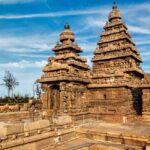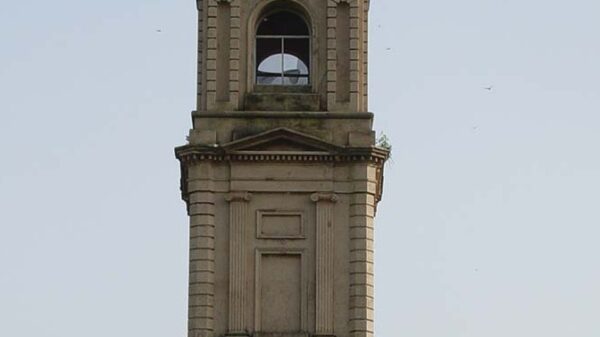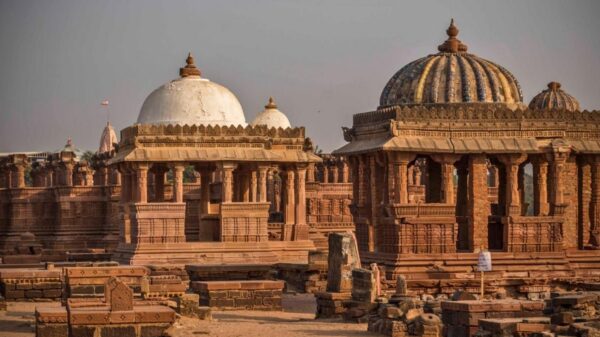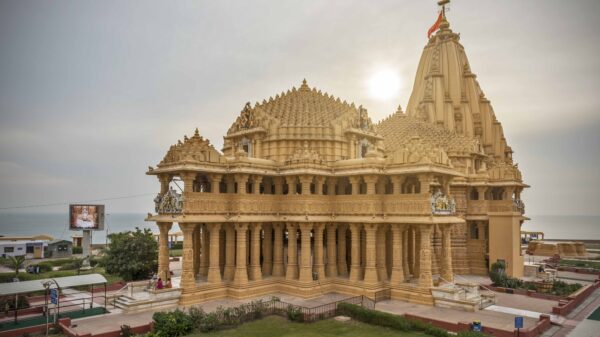Kedarnath is a sacred Hindu settlement located in the Rudraprayag district of Uttarakhand. It’s one of the four Char Dhams in the Himalayas, situated at a remarkable elevation of 3,584 meters above sea level near the source of the Mandakini River
The Kedarnath temple lies amidst the majestic snow-capped Garhwal Himalayan ranges and is thronged by thousands of tourists and pilgrims each year. Also, the Kedarnath trek is stunningly beautiful and quite eclectic, even in the trekking circuit.
Renowned for its historic temple dedicated to Lord Shiva, Kedarnath provides a serene environment set against a picturesque backdrop of rhododendron forests, snow-capped mountains, and stunning natural vistas. It’s a unique blend of spirituality and adventure, making it an unparalleled destination. A definite must-visit for everyone.
Kedarnath literally means the lord of field and it is so called because the ” crop of liberation grows here”. There has been a lot of uncertainty about the construction of Kedarnath temple.
History
It is often believed that after the Battle of Kurukshetra, when the Pandavas emerged victorious over the Kauravas, they were overwhelmed with remorse. In their quest for solace, they embarked on a journey to Banaras to seek blessings from Lord Shiva. However, Shiva eluded them and concealed himself in Guptakashi. As the Pandavas continued their search for God, they eventually encountered

Lord Shiva, disguised himself in the form of a buffalo. Seeing that the Pandavas were drawing nearer, Shiva decided to go underground, becoming invisible. During this phenomenon, one of the Pandavas, Bhima, held onto the buffalo’s legs and tail. Unfortunately, Lord Shiva submerged himself underground, leaving behind the hump, which is now worshipped at the Kedarnath Temple.
It is believed that the Pandavas were absolved of all their worldly sins, and Lord Shiva revealed that henceforth, he would manifest in the form of a jyotirlinga at Kedarnath.
Location
Kedarnath, situated in the Rudraprayag district, is the remotest among the Chota Char Dham sites. It’s nestled near the Chorabari Glacier, the origin of the Mandakini River, and surrounded by snow-capped peaks, notably the Kedarnath mountain (6,940 meters) and the Kedar Dome (6,831 meters). This town lies 223 kilometers away from Rishikesh and is perched on the riverbank.
Tragically, Kedarnath endured significant destruction in 2013 due to flash floods triggered by heavy rains in Uttarakhand. Remarkably, the temple survived these calamities.

The Kedarnath Temple is one of the twelve jyotirlingas of Lord Shiva and holds a special place among the 275 temples of Paadal Petra Sthalams, the most powerful Shiva temples globally. The region offers stunning views of hills and an eclectic environment. It’s a place where beliefs and faiths have thrived, replacing negative emotions with hope and aspiration.
Gandhi Sarovar
Gandhi Sarovar, also known as Chorabari Tal, is a clear lake nestled at the mouth of Chorabari Bamak glacier, beneath Kedarnath and Kirthi Stambh peaks, at a breathtaking altitude of 3,900 meters. This lake is accessible after a 4-kilometer trek from Kedarnath Temple.
Kalimath
Kalimath is a spiritual destination on the banks of the Saraswati River, situated at an elevation of 1800 meters. It’s one of the 108 Shakti Peeths in India, and legend has it that Goddess Kali went underground at this site after defeating Raktbeej.
Bhairav Temple
Bhairavnath Temple, or Bhairon Baba Mandir, lies to the south of the Kedarnath temple on the eastern Himalayan hill. This temple is dedicated to Bhairav, the fierce manifestation of Lord Shiva associated with destruction. It offers stunning views of the Himalayas and adds to the beauty of the journey to Kedarnath.
Geographic coordinates
Kedarnath is a sacred Hindu destination situated in Uttarakhand’s Rudraprayag district. It’s one of the Char Dhams nestled in the Himalayas at a lofty altitude of 3584 meters, near the head of the Mandakini River. The Kedarnath temple stands amidst the majestic Garhwal Himalayan ranges, drawing thousands of pilgrims and tourists annually. The trek to Kedarnath is exceptionally beautiful and diverse.

There are other fascinating destinations that will surely attract your attention.
Vasuki Tal Lake
Vasuki Tal is a high glacial lake perched at a remarkable altitude of 14,200 feet near Kedarnath Dham. The serene lake is surrounded by Himalayan flowers, including the Brahma Kamal, creating breathtaking scenery. The trek from Kedarnath temple to Vasuki Tal is 8 kilometers, with an initial easy stretch before the ascent begins.
Guptakashi
Guptkashi is located 47 kilometers before the revered Kedarnath shrine. Positioned on the route to Kedarnath, it rests on a ridge west of the Mandakini river valley at an elevation of 1,319 meters. Guptkashi is significant for its ancient temples like the Vishwanath temple and Ardhnareshwar temple. The Manikarnika Kund, where the Ganga and Yamuna streams converge, is another revered attraction in this town.
Char Dham Yatra
The Chota Char Dham Yatra in Uttarakhand encompasses the four sacred abodes: Badrinath, Kedarnath, Yamunotri, and Gangotri. All four temples are nestled in the Garhwal region of Uttarakhand and hold immense significance for Hindus. It is believed that every Hindu should undertake the Char Dham Yatra at least once in their lifetime. Adi Shankaracharya, the great reformer and philosopher, established these holy pilgrimage places into a spiritual circuit around the 8th century. Generations have followed in this tradition, making it a common pilgrimage route for devotees.
Best time to visit Kedarnath temple
The best time to visit the Kedarnath Temple in the Indian state of Uttarakhand is during the summer months, typically from May to June, and then again from September to October. During this period, the weather is relatively mild, and the temple is accessible as the snow has melted. However, it’s essential to check for the latest weather and travel conditions before planning your visit, as it can vary from year to year. Also, keep in mind that the temple remains closed during the winter months due to heavy snowfall
How to Reach?
To reach Kedarnath, one of the holiest pilgrimage sites in India, you can follow these steps:
- Reach the Nearest Major City: Start your journey by reaching either Rishikesh or Haridwar. These cities are well-connected by road and rail to major cities in India. The nearest airport is Jolly Grant Airport in Dehradun
- Travel to Gaurikund: From Rishikesh or Haridwar, you’ll need to travel to Gaurikund, which is the base point for Kedarnath. You can hire a taxi, take a bus, or use shared cabs to reach Gaurikund. The road journey can take around 8-10 hours depending on the mode of transport and road conditions.
Gaurikund to Kedarnath:
- Trekking: The most common way to reach Kedarnath from Gaurikund is by trekking. It’s a trek of approximately 16-18 kilometers (10-11 miles) and can take around 6-8 hours, depending on your pace and weather. The path is well-marked, and you’ll pass through beautiful scenery
- Pony or Palanquin: If trekking isn’t an option for you, you can hire a pony or a palanquin (doli) to carry you to Kedarnath. Pony rides are quite common, but keep in mind that the terrain can be steep and challenging.
- Helicopter: There are helicopter services available from Phata, Guptkashi, and other nearby locations to Kedarnath. This is the quickest way to reach the temple, but availability and weather conditions can affect the schedule.
Accommodation:
In Kedarnath, there are various accommodation options, including Dharamshala (guesthouses), tents, and hotels. It’s advisable to book your accommodation in advance, especially during the peak pilgrimage season.
Visiting the Temple:
Once you’ve reached Kedarnath town, the temple is a short walk away. You’ll need to cover a few hundred meters on foot to reach the Kedarnath Temple.
Remember to check the weather and local conditions before your journey, as they can affect travel plans, particularly during the monsoon season and winter months when the temple is closed.
Here are some special tips for visiting Kedarnath:
- Registration: Before embarking on a trip to Kedarnath, make sure to complete the required registration. This step is essential to avoid any logistical issues and ensure a smooth experience.
- Altitude and Trekking Essentials: Given the high altitude and trekking involved, it’s crucial to be prepared.
- Respect the Temple: When visiting the Kedarnath Temple, it’s essential to respect the sacredness of the site. Adhere to the dress code and maintain courtesy and decorum.
- No Photography Inside the Temple:. Respect this rule to honor the sanctity of the place and the privacy of the religious rituals.
- Carry a Basic Medical Kit: It’s a good idea to carry a basic medical kit with essentials like band-aids, pain relievers, antiseptic wipes, and any personal medications you may require.
These tips will help ensure a safe and respectful visit to Kedarnath, allowing you to fully appreciate the spiritual and natural beauty of the region.
Kedarnath, one of the Char Dhams, is a manifestation of one’s solidarity and aspiration. It demonstrates that repentance can fade the tyrannical fury within oneself. The only thing required in your prayers is to be full of love. A visit to Kedarnath will satiate your longing to embrace your Lord. This destination doesn’t require enough praise; its reality can only be fully felt in person. Travel with us.











